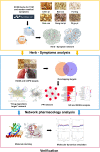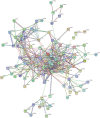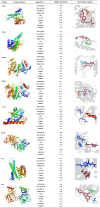Herb-symptom analysis of Erchen decoction combined with Xiebai powder formula and its mechanism in the treatment of chronic obstructive pulmonary disease
- PMID: 37274103
- PMCID: PMC10235815
- DOI: 10.3389/fphar.2023.1117238
Herb-symptom analysis of Erchen decoction combined with Xiebai powder formula and its mechanism in the treatment of chronic obstructive pulmonary disease
Abstract
Background: In recent years, the incidence and mortality rates of chronic obstructive pulmonary disease (COPD) have increased significantly. Erchen Decoction combined with Xiebai Powder (ECXB) formula is mainly used to treat lung diseases in traditional Chinese medicine (TCM). However, the active ingredients of ECXB formula, COPD treatment-related molecular targets, and the mechanisms are still unclear. To reveal its underlying action of mechanism, network pharmacology, molecular docking, and molecular dynamic (MD) simulation approaches were used to predict the active ingredients and potential targets of ECXB formula in treating COPD. As a result, Herb-Symptom analysis showed that the symptoms treated by both TCM and modern medicine of ECXB formula were similar to the symptoms of COPD. Network pharmacology identified 170 active ingredients with 137 targets, and 7,002 COPD targets was obtained. 120 targets were obtained by intersection mapping, among which the core targets include MAPK8, ESR1, TP53, MAPK3, JUN, RELA, MAPK1, and AKT1. Functional enrichment analysis suggested that ECXB formula might exert its treat COPD pharmacological effects in multiple biological processes, such as cell proliferation, apoptosis, inflammatory response, and synaptic connections, and ECXB formula treated COPD of the KEGG potential pathways might be associated with the TNF signaling pathway, cAMP signaling pathway, and VEGF signaling pathway. Molecular docking showed that ECXB formula treatment COPD core active ingredients can bind well to core targets. MD simulations showed that the RELA-beta-sitosterol complex and ESR1-stigmasterol complex exhibited higher conformational stability and lower interaction energy, further confirming the role of ECXB formula in the treatment of COPD through these core components and core targets. Our study analyzed the medication rule of ECXB formula in the treatment of COPD from a new perspective and found that the symptoms treated by both TCM and modern medicine of ECXB formula were similar to the symptoms of COPD. ECXB formula could treat COPD through multi-component, multi-target, and multi-pathway synergistic effects, providing a scientific basis for further study on the mechanism of ECXB formula treatment of COPD. It also provides new ideas for drug development.
Keywords: Erchen decoction; Xiebai powder; chronic obstructive pulmonary disease; herb-symptom analysis; synergistic mechanism; traditional Chinese medicine.
Copyright © 2023 Ye, He, Zhang, Yu, Feng, Wen, Xi and Feng.
Conflict of interest statement
The authors declare that the research was conducted in the absence of any commercial or financial relationships that could be construed as a potential conflict of interest.
Figures













Similar articles
-
[Mechanism of Mahuang Lianqiao Chixiaodou Decoction in treating eczema by network pharmacology and molecular docking technology].Zhongguo Zhong Yao Za Zhi. 2021 Feb;46(4):894-901. doi: 10.19540/j.cnki.cjcmm.20201117.401. Zhongguo Zhong Yao Za Zhi. 2021. PMID: 33645094 Chinese.
-
Exploring the mechanism of Erchen decoction in the treatment of atherosclerosis based on network pharmacology and molecular docking.Medicine (Baltimore). 2023 Nov 17;102(46):e35248. doi: 10.1097/MD.0000000000035248. Medicine (Baltimore). 2023. PMID: 37986321 Free PMC article.
-
Mechanism of Action of Bu-Fei-Yi-Shen Formula in Treating Chronic Obstructive Pulmonary Disease Based on Network Pharmacology Analysis and Molecular Docking Validation.Biomed Res Int. 2020 Nov 26;2020:9105972. doi: 10.1155/2020/9105972. eCollection 2020. Biomed Res Int. 2020. PMID: 33313323 Free PMC article.
-
The pharmacological mechanism of Chinese herbs effective in treating advanced ovarian cancer: Integrated meta-analysis and network pharmacology analysis.Front Pharmacol. 2022 Nov 9;13:1040641. doi: 10.3389/fphar.2022.1040641. eCollection 2022. Front Pharmacol. 2022. PMID: 36438791 Free PMC article.
-
Investigation of the efficacy and potential pharmacological mechanism of Yupingfeng in treating chronic obstructive pulmonary disease: A meta-analysis and in silico study.J Ethnopharmacol. 2025 Mar 13;343:119441. doi: 10.1016/j.jep.2025.119441. Epub 2025 Feb 4. J Ethnopharmacol. 2025. PMID: 39914688
Cited by
-
Network Pharmacology Followed by Experimental Validation to Explore the Mechanism of Stigmasterol in Sangbaipi Decoction Regulating PI3K/Akt Signaling to Alleviate Acute Exacerbation of Chronic Obstructive Pulmonary Disease.Int J Chron Obstruct Pulmon Dis. 2024 Aug 8;19:1819-1834. doi: 10.2147/COPD.S459814. eCollection 2024. Int J Chron Obstruct Pulmon Dis. 2024. PMID: 39140079 Free PMC article.
-
Meta-analysis of the adjuvant treatment of COPD with Erchen Decoction.Medicine (Baltimore). 2025 Jul 11;104(28):e43078. doi: 10.1097/MD.0000000000043078. Medicine (Baltimore). 2025. PMID: 40660578 Free PMC article.
References
-
- Annadurai T., Thomas P. A., Geraldine P. (2013). Ameliorative effect of naringenin on hyperglycemia-mediated inflammation in hepatic and pancreatic tissues of Wistar rats with streptozotocin-nicotinamide-induced experimental diabetes mellitus. Free Radic. Res. 47, 793–803. 10.3109/10715762.2013.823643 - DOI - PubMed
-
- Arora P., Ansari S. H., Nainwal L. M. (2021). Mesua ferrea L. (Calophyllaceae) exerts therapeutic effects in allergic asthma by modulating cytokines production in asthmatic rats. Turk. J. Bot. 45, 820–832. 10.3906/bot-2111-22 - DOI
LinkOut - more resources
Full Text Sources
Research Materials
Miscellaneous

